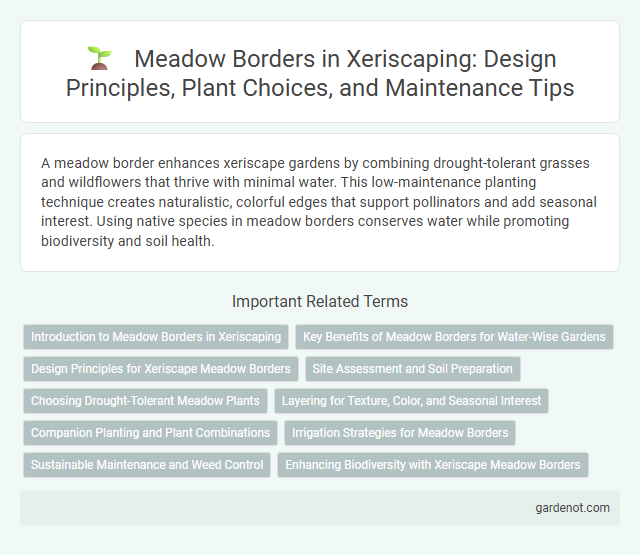A meadow border enhances xeriscape gardens by combining drought-tolerant grasses and wildflowers that thrive with minimal water. This low-maintenance planting technique creates naturalistic, colorful edges that support pollinators and add seasonal interest. Using native species in meadow borders conserves water while promoting biodiversity and soil health.
Introduction to Meadow Borders in Xeriscaping
Meadow borders in xeriscaping create diverse, drought-tolerant landscapes by blending native grasses and wildflowers that require minimal irrigation. These borders enhance biodiversity, support pollinators, and reduce water consumption compared to traditional lawns. Incorporating meadow borders promotes sustainable gardening practices while achieving naturalistic aesthetics in dry climates.
Key Benefits of Meadow Borders for Water-Wise Gardens
Meadow borders enhance water-wise gardens by significantly reducing irrigation needs through the use of drought-tolerant native grasses and wildflowers. These plantings improve soil health and promote biodiversity by attracting pollinators such as bees and butterflies, contributing to a balanced ecosystem. The deep root systems of meadow border species increase water infiltration and retention, minimizing runoff and conserving precious water resources.
Design Principles for Xeriscape Meadow Borders
Xeriscape meadow borders emphasize native, drought-tolerant plants arranged to maximize water efficiency and biodiversity. Design principles include layering vegetation by height to create microclimates, selecting deep-rooted species for soil stabilization, and incorporating mulch or permeable materials to conserve moisture. Strategic placement ensures minimal lawn area, reducing irrigation needs while supporting pollinators and enhancing aesthetic appeal.
Site Assessment and Soil Preparation
Meadow border xeriscapes require thorough site assessment to evaluate sunlight exposure, drainage patterns, and existing soil conditions, ensuring plant selection aligns with the environment. Soil preparation involves amending compacted or nutrient-poor soil with organic matter and incorporating mulch to improve moisture retention while reducing evaporation. Proper grading and removal of invasive species optimize soil health, promoting sustainable growth with minimal irrigation.
Choosing Drought-Tolerant Meadow Plants
Selecting drought-tolerant meadow plants such as native grasses, lavender, and coneflowers ensures a resilient and low-maintenance xeriscape border. These plants thrive in arid conditions, reducing the need for supplemental watering while supporting local pollinators. Incorporating species with deep root systems enhances soil stability and conserves moisture in the landscape.
Layering for Texture, Color, and Seasonal Interest
Meadow borders in xeriscaping use layering techniques to enhance texture, color, and seasonal interest by combining a variety of drought-tolerant grasses, perennials, and wildflowers with different heights and foliage types. Incorporating native species such as Purple Coneflower, Little Bluestem, and Black-Eyed Susan creates a dynamic, visually appealing landscape that thrives with minimal water. This strategic plant layering supports biodiversity and ensures year-round aesthetic appeal in water-efficient garden designs.
Companion Planting and Plant Combinations
Meadow borders thrive with xeriscape-friendly companion planting, combining drought-tolerant species like lavender, echinacea, and ornamental grasses to enhance soil moisture retention and attract pollinators. Strategic plant combinations promote biodiversity, support beneficial insects, and reduce water usage by creating microclimates that lower evaporation rates. Utilizing native wildflowers and resilient perennials in meadow borders optimizes water efficiency and aesthetic appeal in xeriscape garden design.
Irrigation Strategies for Meadow Borders
Meadow border irrigation strategies prioritize water efficiency through drip irrigation and smart controllers that adjust watering schedules based on soil moisture and weather data. Utilizing native drought-tolerant plants reduces overall water demand while maintaining soil health and plant vigor in xeriscape designs. Mulching around meadow borders further conserves moisture and minimizes evaporation, supporting sustainable water use.
Sustainable Maintenance and Weed Control
Meadow border xeriscapes require sustainable maintenance strategies such as selective mowing and targeted mulching to promote native biodiversity while minimizing water use. Implementing dense planting and companion species helps suppress weed growth naturally, reducing the need for chemical herbicides. Consistent monitoring and timely removal of invasive weeds ensure long-term ecosystem health and vibrant meadow borders.
Enhancing Biodiversity with Xeriscape Meadow Borders
Xeriscape meadow borders enhance biodiversity by incorporating native drought-tolerant grasses and wildflowers that provide essential habitats for pollinators such as bees and butterflies. These meadow borders reduce water usage while supporting a resilient ecosystem adapted to arid climates. Integrating xeriscape meadow borders fosters ecological balance and promotes sustainable landscaping practices.
Meadow border Infographic

 gardenot.com
gardenot.com